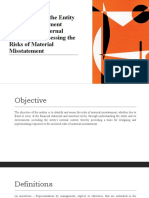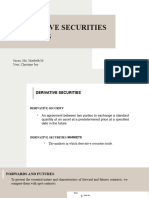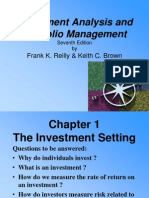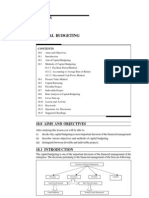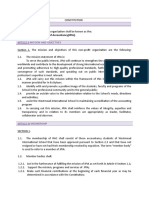Financial Management - Chapter 1 Notes
Uploaded by
sjshubham2Financial Management - Chapter 1 Notes
Uploaded by
sjshubham2Introduction
A corporation pays for its real assets by selling claims on them and on the cash flow that they will
generate. These claims are called financial assets or securities. Securities include bonds, shares,
specialized instruments, etc. Bank loans are assets but not securities because they are not traded in
financial markets.
There are two types of decisions made by a financial manager (Table 1.1):
1. Investment Decisions/Capital Budgeting/CAPEX: Purchase, management & disposition of real
assets. It includes both tangible assets and intangible assets such as R&D. Todays investments
generate future returns but the timing of returns may vary as in case of nuclear plants and
Walmart.
2. Financing Decisions: Sale of financial assets and meeting obligations to banks, shareholders, etc.
Capital is the firms sources of long term financing. Choice between debt and equity financing is
called capital structure decision. If firm borrows, then the firm promises to pay back the debt
plus fixed rate of interest. If shareholders (equity investors) contribute cash, then they do not
get fixed return but fraction of future profits. Equity financing can be done by equity investors or
by reinvesting the cash generated by existing assets (which can otherwise be held as future cash
reserves or paid back to shareholders). Decision to pay dividends or repurchase shares is called
payout decision.
Infosys financing strategy is it carries no debts and finances almost everything by reinvesting cash flows.
Corporation
A corporation is a legal entity owned by its shareholders. It acts as a person who can borrow or lend
money, carry on business, pay taxes, etc. Corporations directors are elected by shareholders advising
top management and signing off some corporate actions. This establishes the separation of ownership
and control. Hudsons Bay Company is one of the oldest companies formed in 1670. Disadvantages of a
corporation is time and money required to manage legal machinery and also corporation pay tax on
their profits and shareholders are taxed again.
There are three objectives of shareholders, i.e., to maximize wealth, decide time pattern of consumption
and manage risk characteristics. Time pattern of consumption and risk characteristics is managed by
shareholders. Fundamental goal of a financial manager is to maximize market value of shareholders
investment and thus maximizing shareholders wealth. However, profit maximization is not a well-
defined financial objective as:
1. Short term profits should not be maximized by damaging long-term profits.
2. Profits increased by cutting dividends and investing cash in firm is not in shareholders best
interest if the return is low.
Decision of an investment manager to take up an investment project depends on shareholders. As long
as the corporations proposed investments offer higher rates of interests than its shareholders can earn
for themselves, they will invest otherwise they will demand their money back. The minimum rate of
return is called the hurdle rate or cost of capital. It is the opportunity cost of capital. Thus, Opportunity
cost of capital is the rate of return that shareholders can get by investing on their own at the same level
of risk as the proposed project. Financial managers invests in projects which earn more than opportunity
cost of capital.
Agency Problems
Separation of ownership and control may lead managers to fulfill their own objectives. E.g.: buy
corporate jets, schedule meetings at high-end places, shy away from risky projects for job safety, etc.
Conflicts between shareholders and managers objectives create agency problems. It arises when
agents (managers) work for principals (shareholders). However, good governance systems can ensure to
handle agency problems. E.g.: Well-designed incentives, accounting standards, investment disclosure,
etc.
You might also like
- Asset Allocation 5E (PB): Balancing Financial Risk, Fifth EditionFrom EverandAsset Allocation 5E (PB): Balancing Financial Risk, Fifth Edition4/5 (13)
- APC 316 Accounting For Special Transactions OkayNo ratings yetAPC 316 Accounting For Special Transactions Okay14 pages
- Advanced Analysis and Appraisal of PerformanceNo ratings yetAdvanced Analysis and Appraisal of Performance19 pages
- Cash Flow and Credit and Background InvestigationNo ratings yetCash Flow and Credit and Background Investigation5 pages
- The Auditor - S Responsibilities - Chapter 3No ratings yetThe Auditor - S Responsibilities - Chapter 338 pages
- Advanced Financial Accounting and Reporting (Afar) Accounting For Joint ArrangementsNo ratings yetAdvanced Financial Accounting and Reporting (Afar) Accounting For Joint Arrangements4 pages
- ACCT 113: Intermediate Accounting 2: Course DescriptionNo ratings yetACCT 113: Intermediate Accounting 2: Course Description1 page
- Review Materials: Prepared By: Junior Philippine Institute of Accountants UC-Banilad Chapter F.Y. 2019-2020No ratings yetReview Materials: Prepared By: Junior Philippine Institute of Accountants UC-Banilad Chapter F.Y. 2019-202033 pages
- Understanding The Entity and Its Environment Including Its Internal Control and Assessing The Risks of Material MisstatementNo ratings yetUnderstanding The Entity and Its Environment Including Its Internal Control and Assessing The Risks of Material Misstatement35 pages
- Audit of The Financing and Investing Cycle ReportNo ratings yetAudit of The Financing and Investing Cycle Report20 pages
- Financial Market Instructional Material by Lascano CompressNo ratings yetFinancial Market Instructional Material by Lascano Compress72 pages
- A-Standards of Ethical Conduct For Management AccountantsNo ratings yetA-Standards of Ethical Conduct For Management Accountants4 pages
- CHAPTER 10 Derivative Securities MarketNo ratings yetCHAPTER 10 Derivative Securities Market26 pages
- Unit Ii: Conventional Finance, Prospect Theory and Market EfficiencyNo ratings yetUnit Ii: Conventional Finance, Prospect Theory and Market Efficiency27 pages
- Rizal Technological University College of Business & Entrepreneurial Technology Department of Accountancy100% (1)Rizal Technological University College of Business & Entrepreneurial Technology Department of Accountancy14 pages
- Other Concepts and Valuation Techniques MA 05.24.23No ratings yetOther Concepts and Valuation Techniques MA 05.24.234 pages
- Accounting 306-01 Controllership in Organizations: Jeffrey C. Fasoldt, CPA CGMA CMA MBA50% (2)Accounting 306-01 Controllership in Organizations: Jeffrey C. Fasoldt, CPA CGMA CMA MBA5 pages
- ACCT 1026 Financial Accounting and Reporting 2019No ratings yetACCT 1026 Financial Accounting and Reporting 201911 pages
- Auditing Theory Review Notes (AT-3) Page 1 of 13: Industry ConditionsNo ratings yetAuditing Theory Review Notes (AT-3) Page 1 of 13: Industry Conditions13 pages
- Revised Guidelines Governing Registration of CooperativesNo ratings yetRevised Guidelines Governing Registration of Cooperatives14 pages
- Chapter 11 Pinoy and Organizational CommunicationNo ratings yetChapter 11 Pinoy and Organizational Communication12 pages
- Chapter 5 Statement of Changes in EquityNo ratings yetChapter 5 Statement of Changes in Equity6 pages
- Investment Analysis and Portfolio Management: Frank K. Reilly & Keith C. BrownNo ratings yetInvestment Analysis and Portfolio Management: Frank K. Reilly & Keith C. Brown42 pages
- Module 1. Corporation and Corporate Governance100% (1)Module 1. Corporation and Corporate Governance29 pages
- Payback Period Method For Capital Budgeting Decisions100% (1)Payback Period Method For Capital Budgeting Decisions5 pages
- Unit 01 Introduction To Business FinanceNo ratings yetUnit 01 Introduction To Business Finance10 pages
- IMT315 LECTURE 12 INTRODUCTION TO PROJECT MANAGEMENT QUIZNo ratings yetIMT315 LECTURE 12 INTRODUCTION TO PROJECT MANAGEMENT QUIZ4 pages
- Get Using SAP An Introduction For Beginners and Business Users Schulz PDF Ebook With Full Chapters Now100% (2)Get Using SAP An Introduction For Beginners and Business Users Schulz PDF Ebook With Full Chapters Now52 pages
- Marketing Mix of Angel'S Hamburger in Olongapo City: ArticleNo ratings yetMarketing Mix of Angel'S Hamburger in Olongapo City: Article2 pages
- CH-4 - Organization and Functioning of Securities MarketNo ratings yetCH-4 - Organization and Functioning of Securities Market13 pages
- The New Age of Pet Insurance Barking Up The Right Tree Codex5666No ratings yetThe New Age of Pet Insurance Barking Up The Right Tree Codex566621 pages
- MARKETING & MANAGEMENT From Rural PerspectiveNo ratings yetMARKETING & MANAGEMENT From Rural Perspective8 pages
- Consumer Advice On Buying Shoes & Lost CardsNo ratings yetConsumer Advice On Buying Shoes & Lost Cards2 pages
- COA Circular No. 2018 002 PROPERTY INVENTORYNo ratings yetCOA Circular No. 2018 002 PROPERTY INVENTORY7 pages
- Tutorial 7 Physical Evidence and The Servicescape: HTM1004 Introduction To Hotel and Tourism IndustryNo ratings yetTutorial 7 Physical Evidence and The Servicescape: HTM1004 Introduction To Hotel and Tourism Industry4 pages
- Market-Based Valuation: Price and Enterprise Value MultiplesNo ratings yetMarket-Based Valuation: Price and Enterprise Value Multiples62 pages


















